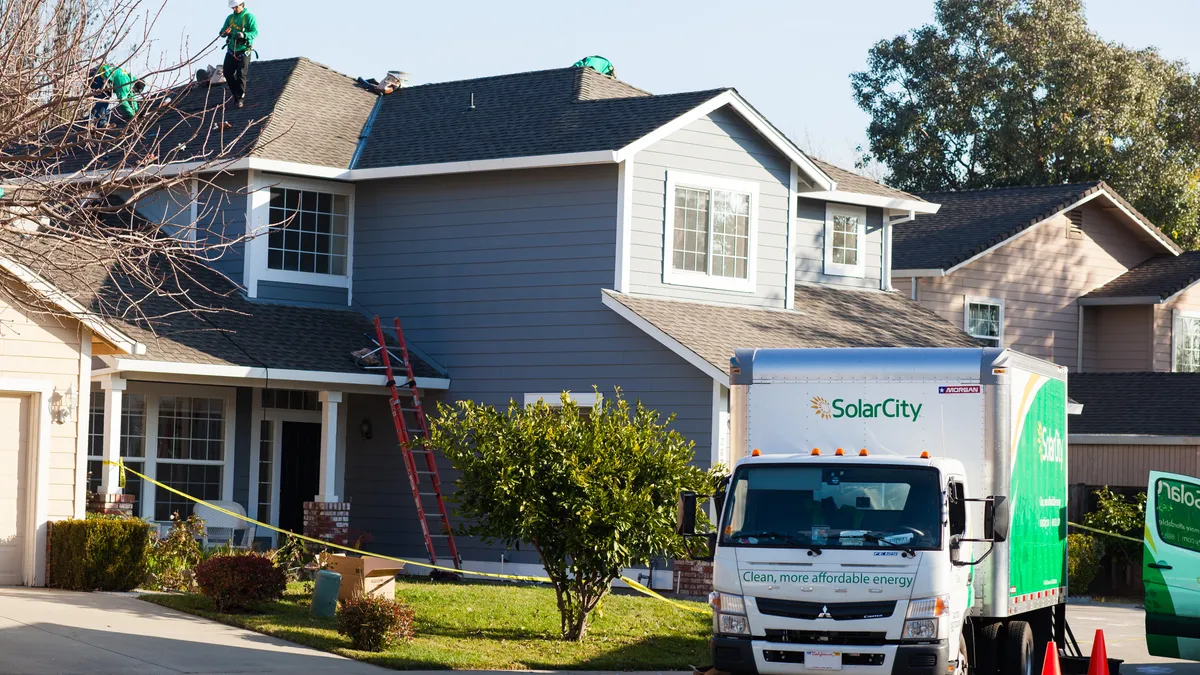Dive Brief:
- California solar advocates are concerned that a new community solar program pitched by the Sacramento Municipal Utility District (SMUD) could hinder the deployment of more rooftop solar.
- The program, approved by the California Energy Commission last week, is the first community solar project under California’s 2019 Energy Code, which took effect on Jan. 1. The code requires new single-family and low-rise residential homes to have a solar photovoltaic system, or participate in community solar as an alternative.
- “One of our primary concerns is we want to make sure that the opportunity for customers to install rooftop solar and storage onsite is not inhibited or deterred by the community solar program that SMUD is offering,” Rick Umoff, senior director and counsel California, at the Solar Energy Industries Association, told Utility Dive
Dive Insight:
The California Energy Commission adopted new building standards last May that would require all new single-family and low-rise residential homes to install a solar photovoltaic system, with the intention of reducing energy use in new homes by half. The standard is expected to reduce greenhouse gas emissions equivalent to taking 115,000 fossil fuel-powered cars off the road, according to the agency. However, the code does allow new constructions to opt instead for a shared community solar system as an alternative to installing an on-site PV infrastructure.
Under SMUD’s Neighborhood SolarShares program, the utility has signed 20-year agreements with developers to provide customers with energy from grid-connected solar arrays. The utility first filed an application for the program last September, which the CEC postponed reviewing at a November meeting after several parties raised concerns about it. In a second version of the application, filed in December, SMUD made a series of tweaks to its original proposal, including committing to get its renewable power from local, smaller sources, and doubling the financial benefit to participating homeowners from $5 per kW per year to $10.
The energy code’s inclusion of community solar was designed to provide flexibility, CEC Commissioner Andrew McAllister said in a press release.
“We expected that the marketplace and stakeholders would find solutions appropriate for their communities. SMUD has created a proposal to do that by offering builders 100 percent solar power at guaranteed savings to their customers. Other community solar proposals will look different. Openness to diverse cost-effective solutions is a hallmark of California’s innovation economy and key to meeting our goals for clean energy, climate, and resilience,” he added.
“This program provides options to builders and a net benefit to potential homebuyers, all while providing clean power to our community," SMUD CEO and General Manager Arlen Orchard said in a statement. "The state of California and the Sacramento region are facing an affordable housing crisis and our low-cost solar option provides a valuable tool to lower the construction costs of new homes while supporting carbon reduction goals.”
SMUD currently has 210 MW of rooftop solar in its service territory, and anticipates that will increase to 600 MW by 2040, Steven Lins, SMUD’s director of government affairs, said at the CEC meeting. Under the program, customers can still add rooftop solar and batteries to their homes. But other stakeholders are wary of the precedent that the solar program could set.
“What SMUD is doing is defining community solar in a way that allows those developers to essentially get out of having to effectively meet a requirement that’s intended to get California and homeowners into a position where they have cleaner energy, cleaner air, and are less vulnerable to [public safety power shut-offs],” Kathryn Phillips, director of Sierra Club California, told Utility Dive.
The program allows builders to pick community solar regardless of whether a home is suited for a solar PV system, Dave Rosenfeld, executive director of the Solar Rights Alliance, told Utility Dive.
“Just like in any business, you’re going to choose the path of least resistance — and for the builder, the path of least resistance is to just let SMUD take care of it,” he said, adding that the program would squander the opportunity provided by new roofs for solar development.
The 20-year commitment to the program is a cause of concern, Umoff indicated, because community solar programs generally allow customers to opt in and out.
“Additionally, we do think that it would be good if SMUD would look at ensuring that its projects are sited strategically in its service territory close to load, so they can provide resiliency benefits to the distributed grid and to local customers” as well as provide a low-income option, he said.
The program’s inclusion of a 20-year lockout “seems a little questionable” to the California Solar and Storage Association, Scott Murtishaw, senior advisor of regulatory affairs, said at the CEC meeting.
"For 20 years, future homeowners — people who may move into that home subsequently to the first buyer — can never substitute their solar shares obligation 100% with a rooftop solar alternative,” Murtishaw said.
However, Neighborhood SolarShares did see support from other parties, including the Natural Resources Defense Council. In comments filed with the commission in early February, Pierre Delforge, senior scientist with the organization, urged the CEC to approve the program, since the revised proposal addressed concerns on project size and customer financial benefits. NRDC also supports taking another look at community solar requirements when the code is updated in 2022.















